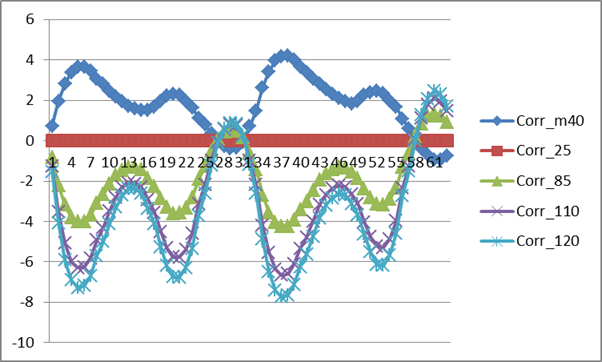SPRACV2 November 2020 AWR1843 , AWR2243
- Trademarks
- 1Introduction
- 2Cascade Incoherence Sources and Mitigation Strategies
-
3Enabling Cascade Coherence and Improved Phase
Performance
- 3.1 High-Level Summary
- 3.2 Saving RF INIT Calibration Results at Customer Factory
- 3.3 Corner Reflector-Based Offsets Measurement at Customer Factory
- 3.4 Restoring Customer Calibration Results In-Field
- 3.5
Host-Based Temperature Calibrations
In-Field
- 3.5.1 Disabling AWR Devices’ Autonomous Run Time Calibrations
- 3.5.2 Enabling Host-Based Temperature Calibrations of Inter-Channel Imbalances
- 3.5.3 Switching of DSP Imbalance Data
- 3.5.4
Enabling TX Phase Shifter’s Host-Based
Temperature Calibrations
- 3.5.4.1 Estimating TX Phase Shift Values at Any Temperature
- 3.5.4.2 Temperature Correction LUTs for AWR1843TX Phase Shifter
- 3.5.4.3 Temperature Correction LUTs for AWR2243 TX Phase Shifter
- 3.5.4.4 Restoring TX Phase Shift Values – Format Conversion
- 3.5.4.5 Restoring TX Phase Shift Values – Transition Timing and Constraints
- 3.5.4.6 Typical Post-Calibration TX Phase Shifter Accuracies
- 3.5.4.7 Correcting for Temperature Drift While Sweeping Across Phase Settings
- 3.5.4.8 Amplitude Stability Across Phase Shifter Settings
- 3.5.4.9 Impact of Customer PCB’s 20-GHz Sync Path Attenuation on TX Phase Shifters
- 3.5.5 Ambient and Device Temperatures
- 4Concept Illustrations
- 5Miscellaneous (Interference, Gain Variation, Sampling Jitter)
- 6Conclusion
- A Appendix
3.5.4.2 Temperature Correction LUTs for AWR1843TX Phase Shifter
Assuming that Tfactory = 25C, Temperature Correction LUT (Tpresent) at Tpresent = -40C, 25C, 85C, 130C for AWR1843 is provided in Table 7 in the Appendix. The same is represented in the form of a graph in Figure 3-3. These are derived from evaluation of a few nominal process based devices in TI labs. The LUT for any temperature is indexed with 0 to 63, corresponding to the 6 bit phase shift index and the output is the correction in the phase angle that is needed. linear interpolation/extrapolation over these temperatures can be used for other temperatures if needed. The data shown below is measured with a single TX been ON at a time. If multiple TXs are ON at the same time the Tx-Tx antenna coupling could cause secondary impact on phase.
 Figure 3-3 Temperature
Correction of TX Phase Shift Error for AWR1843 1
Figure 3-3 Temperature
Correction of TX Phase Shift Error for AWR1843 1- Assuming 25C customer factory calibration, y-axis is phase error in degrees, x-axis is phase shift.